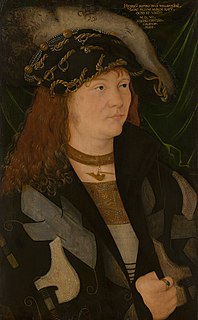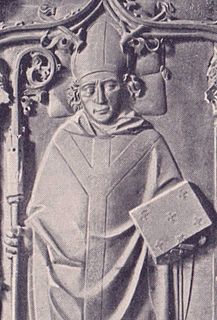Related Research Articles

Albert Suerbeer was the first Archbishop of Riga in Livonia.

Bernard I of Baden was Margrave of the Margraviate of Baden from 1391 to 1431.

Adolf of Denmark or Adolf of Holstein-Gottorp was the first Duke of Holstein-Gottorp from the line of Holstein-Gottorp of the House of Oldenburg.

Rudolf of Zähringen was the archbishop of Mainz from 1160 to 1161 and prince-bishop of Liège. He was the son of Conrad I of Zähringen and Clemence of Luxembourg-Namur.
Berno, Bishop of Schwerin, also known as the Apostle of the Obotrites or Berno of Amelungsborn was a pre-eminent missionary to the Obotrites in the territory of Mecklenburg, Germany, and the first Bishop of Schwerin.

Magnus II, Duke of Mecklenburg-Schwerin and Güstrow was duke of Mecklenburg-Schwerin from 1477 until his death.

John IV of Saxe-Lauenburg was a Prince-Bishop of Hildesheim.

Henry V, Duke of Mecklenburg, nicknamed the Peaceful, was the reigning Duke of Mecklenburg in the region Mecklenburg-Schwerin, the son of Duke Magnus II and Sophie of Pomerania-Stettin.

Rudolf III, a member of the House of Ascania, was Duke of Saxe-Wittenberg and Elector of Saxony from 1388 until his death.
Pribislaw I, Lord of Parchim-Richenberg, was Lord of Parchim-Richenberg from 1238 to 1256.

John Albert I, Duke of Mecklenburg, in older literature known as John or Johann, was the reigning Duke of Mecklenburg-Güstrow from 1547 to 1556 and of Mecklenburg-Schwerin from 1556 to 1576. In 1549 John Albert I saw to it that the parliament of Mecklenburg carried through the Reformation for the entire Duchy.
Pribislaw II was a prince from the Parchim-Richenberg line of the House of Mecklenburg. He was Lord of Białogard from 1270 until his death.

Otto IV, Margrave of Brandenburg-Stendal, nicknamed Otto with the arrow was the Margrave of Brandenburg from the House of Ascania from 1266 until his death.

Bertold of Landsberg was bishop of Verden. He was also Bishop of Hildesheim as Berthold II.

Christopher, Duke of Mecklenburg-Gadebusch was a son of Albrecht VII, Duke of Mecklenburg. He was Duke of Mecklenburg-Gadebusch, as well as administrator of Ratzeburg and of the Commandery of Mirow.

Anselm of Meissen was a priest of the Teutonic Order and the first actual Bishop of Warmia.
Hildebold of Wunstorf , also Hildbold , was the Prince-Archbishop of Bremen from 1258 until his death.
The Udonids (Udonen) were a German noble family, ruling as both the Counts of Stade and Margraves of the Nordmark, or Northern March, from the 9th to the 12th century. The first formal member of this family was Henry I the Bald, who took his seat in Harsefeld, part of the Duchy of Franconia, where he built a castle in 965. He was the grandson of the first Count of Stade, Lothar I, who was killed by the Great Heathen Army in the Battle of Ebstorf, and was recognized as one of the Martyrs of Ebsdorf by the Catholic Church.

Conrad of Babenberg was a nobleman and prelate of the Holy Roman Empire. He was the bishop of Passau from 1148/1149 until 1164 and then archbishop of Salzburg until his death, although he lost control of Salzburg when he was placed under the imperial ban in 1166.

Rudolf III von Montfort was bishop of Chur (1322–1325) and Konstanz (1322–1334). He was born into the young family of Montfort-Feldkirch of the Swabian noble family of Montfort.
References
- Krause (1889), "Rudolf I.", Allgemeine Deutsche Biographie (ADB) (in German), 29, Leipzig: Duncker & Humblot, pp. 561–562
- Oliver Auge (2005), "Rudolf I.", Neue Deutsche Biographie (in German), 22, Berlin: Duncker & Humblot, p. 188